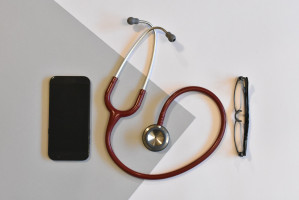
Although many diseases have no obvious symptoms in the early diagnosis, it’s proved that human body would defend itself through the immune system in the early stage of disease.
Corresponding signals, such as sweat, urine, tears, blood, exhaled breath, are usually sent out for early warning.
Recently, a new invention by Prof. JIANG Changlong's research team from the Institute of Solid State Physics, Hefei Institutes of Physical Science, Chinese Academy of Sciences, realized visual detection analysis for lung cancer and ketosis/diabetes via different testing probes.
The team designed and prepared two high-efficiency organic ratio fluorescent nanoprobes, and realized the detection of biomarkers in exhaled breath by combining with the colour recognizer of the smartphone.
A portable smartphone platform based on a single-particle dual-emission ratio fluorescent probe they designed realized the visual detection of isopropanol in exhaled breath to achieve the purpose of early warning of lung cancer risk.
Another fluorescent sensor platform designed by them effectively captured acetone in blood and exhaled breath and warn ketosis/diabetes.
Researchers developed corresponding ratio fluorescent probes to identify acetone and isopropanol, and used the 3D printing technology and a smartphone APP (colour recognizer) to complete the visualization, on-site and semi-quantitative detection of biomarkers.
Through the ratio fluorescence strategy, two different colours of fluorescence probe are mixed at an appropriate ratio.
When the biomarker is present, one type of fluorescence is quenched while the internal standard fluorescence remains unchanged, so that it can present a clear colour under a UV lamp irradiation.
Using a smartphone to recognise the colour RGB value of the fluorescent probe solution can realize the visualization, real-time and semi-quantitative detection of the target analyte.
This ratio probe is prepared by carbon dots with low toxicity, high luminous efficiency and organic fluorescent materials with a wide luminous colour range, easy modification of the structure, and good tunability.
It has a lower detection limit for biomarkers, which can realize early warning of human health.
Combined with the fluorescence sensing platform prepared by the smart phone, it can perform on-site, fast, semi-quantitative, and visual detection.
The related results have been published in Analytical Chemistry as cover story and Microchimica Acta.
The two designed methods provide a convenient way and expected to expand the application of potential volatile biomarker research for preliminary monitoring and clinical diagnosis.
Source: Hefei Institutes of Physical Science, Chinese Academy of Sciences
We are an independent charity and are not backed by a large company or society. We raise every penny ourselves to improve the standards of cancer care through education. You can help us continue our work to address inequalities in cancer care by making a donation.
Any donation, however small, contributes directly towards the costs of creating and sharing free oncology education.
Together we can get better outcomes for patients by tackling global inequalities in access to the results of cancer research.
Thank you for your support.